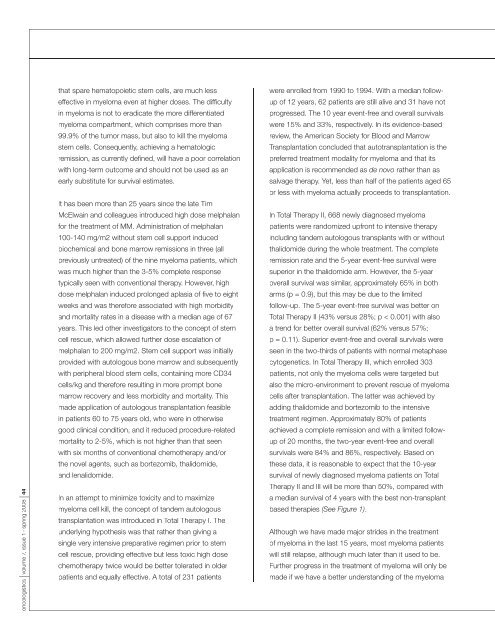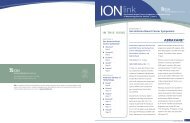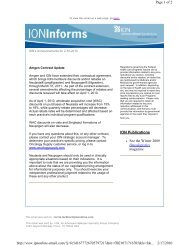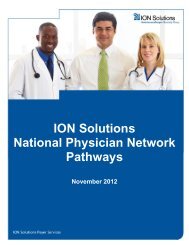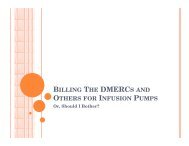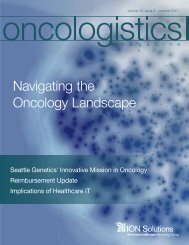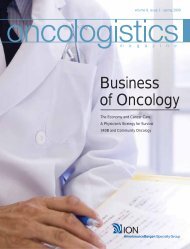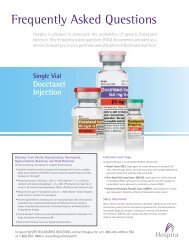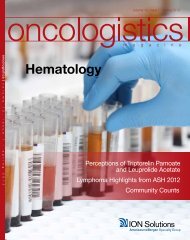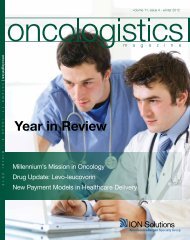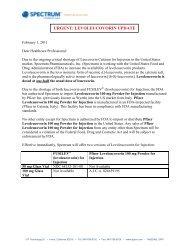First Quarter 2008 - Issues in Hematology - ION Solutions
First Quarter 2008 - Issues in Hematology - ION Solutions
First Quarter 2008 - Issues in Hematology - ION Solutions
- No tags were found...
Create successful ePaper yourself
Turn your PDF publications into a flip-book with our unique Google optimized e-Paper software.
oncologistics volume 7, issue 1 - spr<strong>in</strong>g <strong>2008</strong> 44that spare hematopoietic stem cells, are much lesseffective <strong>in</strong> myeloma even at higher doses. The diffi culty<strong>in</strong> myeloma is not to eradicate the more differentiatedmyeloma compartment, which comprises more than99.9% of the tumor mass, but also to kill the myelomastem cells. Consequently, achiev<strong>in</strong>g a hematologicremission, as currently defi ned, will have a poor correlationwith long-term outcome and should not be used as anearly substitute for survival estimates.It has been more than 25 years s<strong>in</strong>ce the late TimMcElwa<strong>in</strong> and colleagues <strong>in</strong>troduced high dose melphalanfor the treatment of MM. Adm<strong>in</strong>istration of melphalan100-140 mg/m2 without stem cell support <strong>in</strong>ducedbiochemical and bone marrow remissions <strong>in</strong> three (allpreviously untreated) of the n<strong>in</strong>e myeloma patients, whichwas much higher than the 3-5% complete responsetypically seen with conventional therapy. However, highdose melphalan <strong>in</strong>duced prolonged aplasia of fi ve to eightweeks and was therefore associated with high morbidityand mortality rates <strong>in</strong> a disease with a median age of 67years. This led other <strong>in</strong>vestigators to the concept of stemcell rescue, which allowed further dose escalation ofmelphalan to 200 mg/m2. Stem cell support was <strong>in</strong>itiallyprovided with autologous bone marrow and subsequentlywith peripheral blood stem cells, conta<strong>in</strong><strong>in</strong>g more CD34cells/kg and therefore result<strong>in</strong>g <strong>in</strong> more prompt bonemarrow recovery and less morbidity and mortality. Thismade application of autologous transplantation feasible<strong>in</strong> patients 60 to 75 years old, who were <strong>in</strong> otherwisegood cl<strong>in</strong>ical condition, and it reduced procedure-relatedmortality to 2-5%, which is not higher than that seenwith six months of conventional chemotherapy and/orthe novel agents, such as bortezomib, thalidomide,and lenalidomide.In an attempt to m<strong>in</strong>imize toxicity and to maximizemyeloma cell kill, the concept of tandem autologoustransplantation was <strong>in</strong>troduced <strong>in</strong> Total Therapy I. Theunderly<strong>in</strong>g hypothesis was that rather than giv<strong>in</strong>g as<strong>in</strong>gle very <strong>in</strong>tensive preparative regimen prior to stemcell rescue, provid<strong>in</strong>g effective but less toxic high dosechemotherapy twice would be better tolerated <strong>in</strong> olderpatients and equally effective. A total of 231 patientswere enrolled from 1990 to 1994. With a median followupof 12 years, 62 patients are still alive and 31 have notprogressed. The 10 year event-free and overall survivalswere 15% and 33%, respectively. In its evidence-basedreview, the American Society for Blood and MarrowTransplantation concluded that autotransplantation is thepreferred treatment modality for myeloma and that itsapplication is recommended as de novo rather than assalvage therapy. Yet, less than half of the patients aged 65or less with myeloma actually proceeds to transplantation.In Total Therapy II, 668 newly diagnosed myelomapatients were randomized upfront to <strong>in</strong>tensive therapy<strong>in</strong>clud<strong>in</strong>g tandem autologous transplants with or withoutthalidomide dur<strong>in</strong>g the whole treatment. The completeremission rate and the 5-year event-free survival weresuperior <strong>in</strong> the thalidomide arm. However, the 5-yearoverall survival was similar, approximately 65% <strong>in</strong> botharms (p = 0.9), but this may be due to the limitedfollow-up. The 5-year event-free survival was better onTotal Therapy II (43% versus 28%; p < 0.001) with alsoa trend for better overall survival (62% versus 57%;p = 0.11). Superior event-free and overall survivals wereseen <strong>in</strong> the two-thirds of patients with normal metaphasecytogenetics. In Total Therapy III, which enrolled 303patients, not only the myeloma cells were targeted butalso the micro-environment to prevent rescue of myelomacells after transplantation. The latter was achieved byadd<strong>in</strong>g thalidomide and bortezomib to the <strong>in</strong>tensivetreatment regimen. Approximately 80% of patientsachieved a complete remission and with a limited followupof 20 months, the two-year event-free and overallsurvivals were 84% and 86%, respectively. Based onthese data, it is reasonable to expect that the 10-yearsurvival of newly diagnosed myeloma patients on TotalTherapy II and III will be more than 50%, compared witha median survival of 4 years with the best non-transplantbased therapies (See Figure 1).Although we have made major strides <strong>in</strong> the treatmentof myeloma <strong>in</strong> the last 15 years, most myeloma patientswill still relapse, although much later than it used to be.Further progress <strong>in</strong> the treatment of myeloma will only bemade if we have a better understand<strong>in</strong>g of the myeloma


